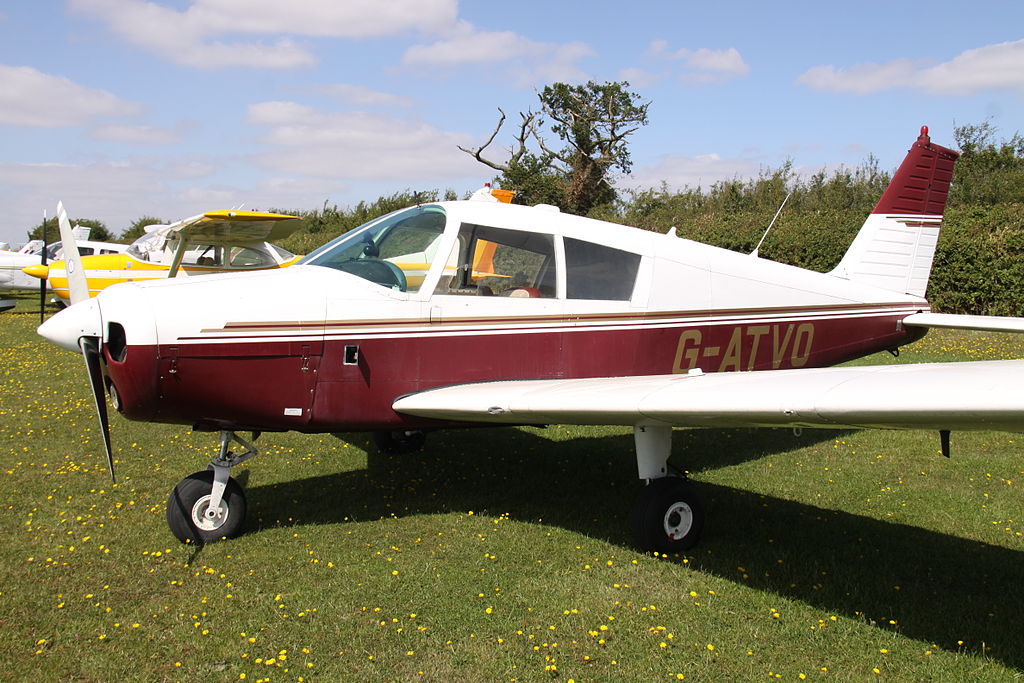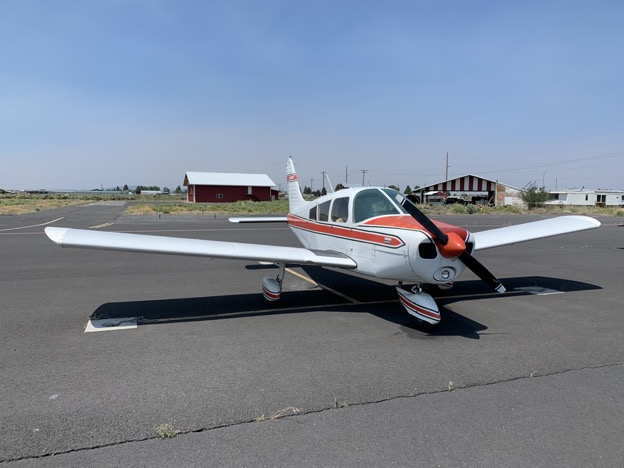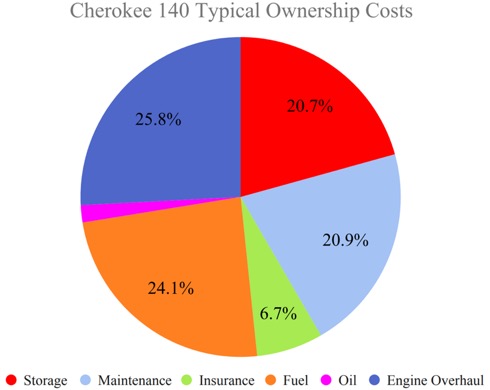
The Piper Cherokee 140 is an immensely popular general aviation aircraft for several good reasons. They are easy to fly, reliable, and generally have a low ownership cost. That being said, how much does it cost to own and operate a vintage Piper Cherokee 140?
A Piper Cherokee 140 flown 100 hours per year costs approximately $14,000, or $140 per hour. Flown 150 hours per year, it costs roughly $17,500, or $117 per hour. Expect $7,000 in annual fixed costs (regardless of time flown) and approximately $70 per hour in variable costs per hour flown.
In this article, we will discuss my personal operating costs for owning and flying my 1968 Cherokee 140 based in Bend, a medium-sized city in Central Oregon, United States. Your personal costs could vary quite a bit, but the numbers presented here will give you a starting point in your personal planning.
As pilots, planning is an extremely important skill, and this includes financial planning. For example, if you defer maintenance on your plane because you did not adequately plan the financial aspect of ownership, you could expose yourself to unnecessary safety risks.
If you would like to use a convenient web tool to estimate ownership costs for a plane you own (or want to own), it is linked at the bottom of this article.
Acquisition Costs
I spent several months last year looking at websites like Barnstormers and Trade-a-Plane to find a good deal on a trainer aircraft.
I knew I wanted a plane with a relatively low operating cost, solid maintenance history, and that I could afford to purchase without a loan.
I found my Cherokee on Barnstormers.com and purchased it for $27,200.
Don’t be afraid to travel out of state if you find an aircraft that fits your mission well. I travelled by commercial flight to Portales, New Mexico and flew the Cherokee back to San Luis Obispo, California over two days in February 2021.
It was a great way to get acquainted with my new ride!

The thing to keep in mind about acquisition cost is that that money is not gone forever (unlike fuel costs).
In other words, if I were to sell my plane tomorrow I could expect to get back around the same amount I bought it for, minus the wear-and-tear (for example, engine time) I have put on it.
Depreciation is worth mentioning here. Much like cars, airplanes depreciate in value over time (with few exceptions).
Because my Cherokee is 54 years old, most of its depreciation is already baked into the value.
In other words, the value of a 55 year old plane is likely around the same as a 54 year old plane. Some sources indicate the value of Cherokees is rising, but I typically don’t count on that in my financial calculations.
Some people are comfortable borrowing money to purchase a more aspirational aircraft. This didn’t interest me, as I didn’t want another monthly bill to worry about.
For this reason, I purchased the aircraft with cash.
That being said, getting a personal loan for an aircraft is certainly a popular and viable option but should be approached with careful and honest financial planning.
Pre-Purchase Inspection
It is always wise to have an independent mechanic (not the seller’s mechanic) conduct a thorough pre-purchase inspection any time you are considering buying an aircraft.
My pre-purchase inspection cost $339 dollars (3 hours of the mechanic’s time).
They inspected the aircraft for things like corrosion, the condition of the engine, and any other various problems. Importantly, they read all the logbooks to make sure they were complete and that there were no surprises.
If you hire a mechanic for a PPI and they find problems that convince you not to buy a plane, don’t be disappointed. Be glad you likely saved thousands of dollars on headaches down the road.
Costs of Owning and Operating a Cherokee 140
Ongoing costs to own and fly any airplane are comprised of fixed costs and variable costs. Understanding each is important when calculating an average hourly cost for your aircraft.
Fixed Costs
These are the costs that I incur even if I don’t fly a single hour in a year. The more you fly, the more you can spread these fixed costs across your hours flown, effectively reducing your average hourly rate to operate the airplane.
Insurance
Insurance is a fixed cost that you typically pay once per year. My insurance costs me $80 per month, or $960 per year.
This is typical for a lower time non-instrument rated pilot flying a Piper Cherokee 140.
For reference, I currently have 180 total hours, 75 of which are in a PA-28-140. When I get my instrument rating, this rate may decrease slightly.
To my fellow pilots out there, please fly safely so my rates stay low!
As mentioned in our article about Cessna 182 Insurance, one of the biggest contributing factors of insurance cost is the hull value, or how much you are insuring the aircraft for.
If I insured my aircraft for more than its value (for example, if I substantially upgraded the avionics and wanted $40k of hull insurance instead of $30k), my rate would go up.
Aircraft Storage
Aircraft storage is another fixed cost that is important to consider. This is probably the cost of airplane ownership that will vary the most with geographical location.
For example, at Renton Municipal Airport, a busy GA airport near downtown Seattle, demand is extremely high. The monthly cost for a small T-hangar is nearly $500 per month, with a 7 to 10 year waitlist.
On the flip side, if you live somewhere where demand is lower, you might be pleasantly surprised to learn how affordable it is to store your plane in a hangar. A small T-hangar in Cedar Rapids, Iowa will only cost you $68 per month.
You should consider the current condition of your plane, climate, and cost when weighing whether to store your plane indoors or outdoors.
When I moved to Oregon from California this summer, I had to consider the new weather conditions my plane would encounter. Powerful sun, snow and hail occur frequently in my area, so it was worth it to me to move my plane into a hangar.
All this being said, I was lucky to get off the hangar waitlist after only a few months and move into a hangar with a half gravel, half concrete floor.
My hangar costs $247 per month, or $2,964 per year.
While this is significantly higher than the $45 a month for a tie down in Bend, the airplane is largely protected from the rain, wind, and elements which far outweighs the cost for me. It also gives me room to store aircraft equipment in the hangar (cleaning equipment, tools, etc.).

Inspections and Maintenance
Inspections and maintenance could almost be considered a variable cost, but for our purposes we will call them a fixed cost.
Although certain things like tires and spark plugs will need to be replaced the more you use a plane, other costs like annual inspections are fixed year to year.
Maintenance costs are also one of the hardest costs to predict. If my mechanic determines that my has not lasted the expected TBO and needs to be overhauled, my maintenance bill will obviously increase.
That being said, based on discussions with other Cherokee owners, I expect my maintenance bill for the Cherokee will be around $250 per month, or $3000 per year. This does not include an engine overhaul fund, which we will discuss later.
Variable Costs
As the name implies, variable costs vary with how much you fly. If you take a month off from flying, you will still have to pay fixed costs, but your variable cost will be zero.
Fuel
At my local airport in Bend, 100LL fuel currently costs $4.70 per gallon as of this writing. I plan on burning 7.5 gallons per hour, meaning each operating hour costs $35 in fuel alone.
When fuel prices fluctuate, this variable cost fluctuates as well.
If you are used to a “wet” rental rate (where fuel is already included in your hourly rate) and are considering purchasing your own aircraft, this can take some getting used to!
That being said, nothing is better than those days where you arrive at the airport to a fully fueled plane, fly around for a few hours, land, and go home – all while your bank balance remains untouched.
Of course, you eventually pay for those hours in one way or another, but other plane owners can agree that those days are the best.
Oil
The Cherokee 140 takes 8 quarts of Aeroshell W100 Plus aviation oil in its Lycoming O-320 engine. I would highly recommend buying the oil in bulk online. A six-quart pack of oil online costs $52, so 8 quarts costs around $70. The spin-on Champion CH48110-1 oil filter used on the Cherokee costs $30.
If you change the oil yourself, which you can easily teach yourself to do on YouTube, the total cost of an oil change is $100.
I change my oil every 40 hours, meaning that each operating hour costs approximately $2.50 in oil. If you pay a mechanic to change your oil, you could expect to approximately double that cost.
Engine Overhaul Fund
The most expensive variable cost in operating my Cherokee 140 is the engine overhaul reserve.
Saving up money for an eventual engine overhaul is something you might want to factor into your hourly operating cost.
Aircraft engines are reliable and well-engineered machines, but everything wears down eventually. That’s where an engine overhaul comes in.
Overhauling an aircraft engine typically involves taking it out of the aircraft, disassembling it, inspecting it, repairing it as necessary, reassembling it, and reinstalling it in the plane.
The many hours of highly skilled labor involved and the relatively low volumes of general aviation piston engines being overhauled add up to a whopping bill!
Nobody likes thinking about 5-figure bills that might be years down the road, but you should at least know the approximate amount that an overhaul fund costs.
Thinking of only short term costs like fuel can lull you into thinking owning and operating a plane is cheaper than it really is. That being said, let’s take a look at some numbers for an engine overhaul fund of a Cherokee 140.
Looking online, the average cost of overhauling the engine in my plane, a Lycoming O-320-E2A, is $23,000.
As of this writing, my plane has around 1400 hours on the engine (TSMOH, or Time Since Major Overhaul). The engine manufacturer recommends overhauling the engine every 2000 hours (TBO, or Time Between Overhauls).
We can use this intuitive formula to determine what I should budget per hour for an eventual overhaul:
Engine overhaul fund: (TBO – TSMOH)/(cost of overhaul)
My 2000-1400 = 600 hours until overhaul.
Overhaul cost = $23,000
$23,000/600 hours = $38.33 per hour
Put simply, each hour I fly I should save $38.33 for an eventual engine overhaul. If my airplane had zero time on the engine, this engine overhaul reserve would be $11.50 per hour.
Engine overhaul TBOs are just estimates. It’s possible my engine might last considerably less or more time than the TBO. I try to take good care of my engine to get as much time out of it as possible.
Ways I Could Save Money on My Cherokee 140
It’s often wise to do a self-audit and brainstorm a few ways you could save money.
The most impactful cost saving measure I could implement would be to find a partner to purchase half of my plane – this would put a large amount of money in my pocket and slash all the fixed costs in half.
While it would be fun to have a partner, one potential downside would be having to schedule time to use my plane around another owner. Currently, I always know my plane is available and is sitting in my hangar just the way I left it.
Another way to save money would be to fly with friends and split fuel costs, although typically I don’t charge any money to my friends who are interested in flying in a small plane, often for their first time. Sometimes on long cross country trips I will split fuel costs with a friend.
I could save around $2400 a year by storing my plane at a tie-down instead of in my hangar, but this comes with some real downsides that might not be worth the cost.
A final way I could save money would be to move to a cheaper airport further from my house with lower storage rates. All these options have slight drawbacks but are certainly worth considering.
Piper Cherokee Ownership Cost Summary
Breaking down your operating cost per hour can be a sobering experience for an aircraft owner. It’s important to think ahead so that you are not caught off guard by the various expenses associated with owning and operating your own aircraft.
You can download a template for calculating aircraft ownership costs here, and modify it for your particular aircraft and situation. You’ll get data like the following:


While it is important to know the ownership costs of your aircraft, I can’t say I recommend thinking about it too often. I would strongly discourage getting in the mindset of “I want to go fly, but will this sunset be worth X amount of dollars?”
Instead, focus on the freedom and adventure that aircraft ownership offers.
Don’t be unrealistic or purchase a plane you can’t afford, but don’t focus solely on your bank balance when pursuing your aviation dreams. At least, that’s how I’ve chosen to think about it.
When I was cruising around Mt. St. Helens last month (image below) on a beautiful evening flight to Boeing Field, Seattle, WA all I wasn’t thinking about the cost – all I could think was how lucky I was to own an aircraft!




